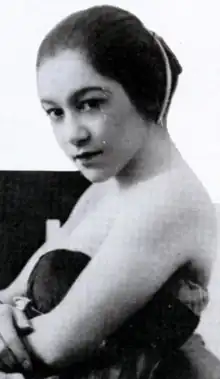Lady Tsen Mei | |
|---|---|
 Lady Tsen Mei, from a 1918 publication. | |
| Born | Josephine Augusta Moy March 28, 1888 Philadelphia, Pennsylvania |
| Died | July 1985 Norfolk, Virginia |
| Other names | Tsen Mei, Sen Mei, Josephine Kramer |
| Occupation | Actress |
Josephine Augusta Moy (March 28, 1888 – July 1985), known professionally as Lady Tsen Mei, was an American actress and singer. She was billed as "the screen's only Chinese star" in publicity for her first film, For the Freedom of the East (1918).[1]
Early life
Josephine Augusta Moy was born in Philadelphia, the daughter of Shu Chong Moy and Jessica Whitehurst. Her father was born in China and her mother in Virginia. She was later raised by a foster father, Jin Fuey Moy, who was born in China, trained as a physician in the United States, and faced repeated legal difficulties involving his personal relationships, narcotics, and human trafficking.[2][3] She was raised in Pittsburgh's Chinatown.[4]
Moy is described as "multiracial".[5] Being of Chinese ethnicity from her father's side and of mostly white European descent on her mother's side, she was identified as white in the 1910 census.[6] Her Chinese ancestry was often emphasized in films and film publicity; through her mother she also had some African ancestry.[5]
Career
Moy appeared on the American vaudeville stage as Lady Tsen Mei as early as 1915,[7][8] and into the mid-1920s.[9] One of her vaudeville acts involved singing to imitate various birds.[10] She toured in Australia and China as a singer and actress in 1916 and 1917, and in England and France in 1919. She sang the title role in a 1919 revival of The Geisha, though a critic commented that "her vocal means are slight and technically hampered."[11]
She was featured in several American-made silent films, in roles and with publicity that emphasized her Chinese ancestry. She played a Chinese freedom fighter in For the Freedom of the East (1918, now lost), a film made by the Betzwood Film Company in Pennsylvania. She held top billing in Lotus Blossom (1921), a drama set in historical China, co-directed and co-written by James B. Leong.[12][13] In The Letter (1929), an early talking picture, Lady Tsen Mei appears alongside Jeanne Eagels, in a pre-Code murder drama set in Singapore.[14][15] She was also seen in Daughter of Heaven (1930).[16]
Lady Tsen Mei was the first actress of color given a full-page feature in Photoplay magazine;[17] the 1918 feature, and similar accounts, included various stories fabricated to increase her exotic appeal, such as a mentions of her being born in China, and attending medical school (or law school, or, in some accounts, both).[18][19][20] Mentions of her athletic prowess, however, seem to have had a stronger basis in fact.[21]
Personal life
Moy married twice and had a daughter. She was widowed when Archibald E. Kramer died in 1971, and she died Norfolk, Virginia in 1985, aged 97 years. In recent years, American film scholar Ramona Curry has reconstructed the life and career of Lady Tsen Mei.[22]
References
- ↑ "Advertisement". The Moving Picture World. World Photographic Publishing Company. October 5, 1918. p. 38.
- ↑ Seligman, Scott D. (2012). Three tough Chinamen. Hong Kong: Earnshaw Books. ISBN 978-988-16162-8-9. OCLC 811349295.
- ↑ "Death Takes Dr. Moy, Who Was Principal in Notorious Opium Case". Pittsburgh Post-Gazette. 1924-05-05. p. 2. Retrieved 2020-11-22 – via Newspapers.com.
- ↑ "Local Chinese Will Observe New Year". The Pittsburgh Press. 1912-12-27. p. 5. Retrieved 2020-11-22 – via Newspapers.com.
- 1 2 Cho, Jenny (2013). Chinese in Hollywood. Chinese Historical Society of Southern California. Arcadia Publishing. pp. 7, 16. ISBN 978-0-7385-9973-1.
- ↑ 1910; Census Place: Park Ridge, Bergen, New Jersey; Roll: T624_869; Page: 19A; Enumeration District: 0033; FHL microfilm: 1374882. via Ancestry.
- ↑ Moon, Krystyn R. (2004-11-03). Yellowface: Creating the Chinese in American Popular Music and Performance, 1850s-1920s. Rutgers University Press. p. 155. ISBN 978-0-8135-4122-8.
- ↑ "The Orpheum". The Argonaut. 89: 106. August 13, 1921.
- ↑ "Lady Tsen Mei on Loew's Vaudeville Bill for All Week". The Dayton Herald. 1924-01-24. p. 11. Retrieved 2020-11-21 – via Newspapers.com.
- ↑ "Chinese Nightingale". The Pittsburgh Press. 1927-05-29. p. 30. Retrieved 2020-11-22 – via Newspapers.com.
- ↑ Peyser, Herbert F. (November 1, 1919). "'Geisha' Revival Worth While". Musical America. 31: 4.
- ↑ Metzger, Sean (2014-04-25). Chinese Looks: Fashion, Performance, Race. Indiana University Press. pp. 75–76. ISBN 978-0-253-01568-6.
- ↑ "National Films Score Big in Coast Houses". Exhibitors Trade Review. 11: 176. December 17, 1921.
- ↑ "Lady Tsen Mei Back to Native Role Now". News-Journal. 1929-03-09. p. 10. Retrieved 2020-11-22 – via Newspapers.com.
- ↑ Kingsley, Grace (1928-11-01). "Lasky Signs More Stage Actors". The Los Angeles Times. p. 38. Retrieved 2020-11-22 – via Newspapers.com.
- ↑ "Chinese Star is Versatile". Los Angeles Evening Post-Record. 1930-05-07. p. 6. Retrieved 2020-11-22 – via Newspapers.com.
- ↑ Carson, Norma Bright (December 1918). "Lady Tsen Mei, of China". Photoplay World: 37 – via Internet Archive.
- ↑ Buszek, Maria Elena (2006-05-31). Pin-Up Grrrls: Feminism, Sexuality, Popular Culture. Duke University Press. p. 164. ISBN 978-0-8223-3746-1.
- ↑ "Tells About the People of the Screen". Dramatic Mirror. 78: 924. June 20, 1918.
- ↑ "Doctor, Lawyer, Actress". The Ellis Review-Headlight. 1920-09-24. p. 1. Retrieved 2020-11-21 – via Newspapers.com.
- ↑ "Charming Young Woman from the Orient Delights Theatregoers". The Central New Jersey Home News. 1919-05-04. p. 11. Retrieved 2020-11-21 – via Newspapers.com.
- ↑ Spitzzeri, Paul R. (2018-03-26). "Dr. Ramona Curry on Lady Tsen Mei, the First Chinese-American Film Star". The Homestead Blog. Retrieved 2020-11-21.
External links
- Lady Tsen Mei at IMDb
- The Letter (1929), a film starring Jeanne Eagels and featuring Lady Tsen Mei.
- Lady Tsen Mei at Find a Grave